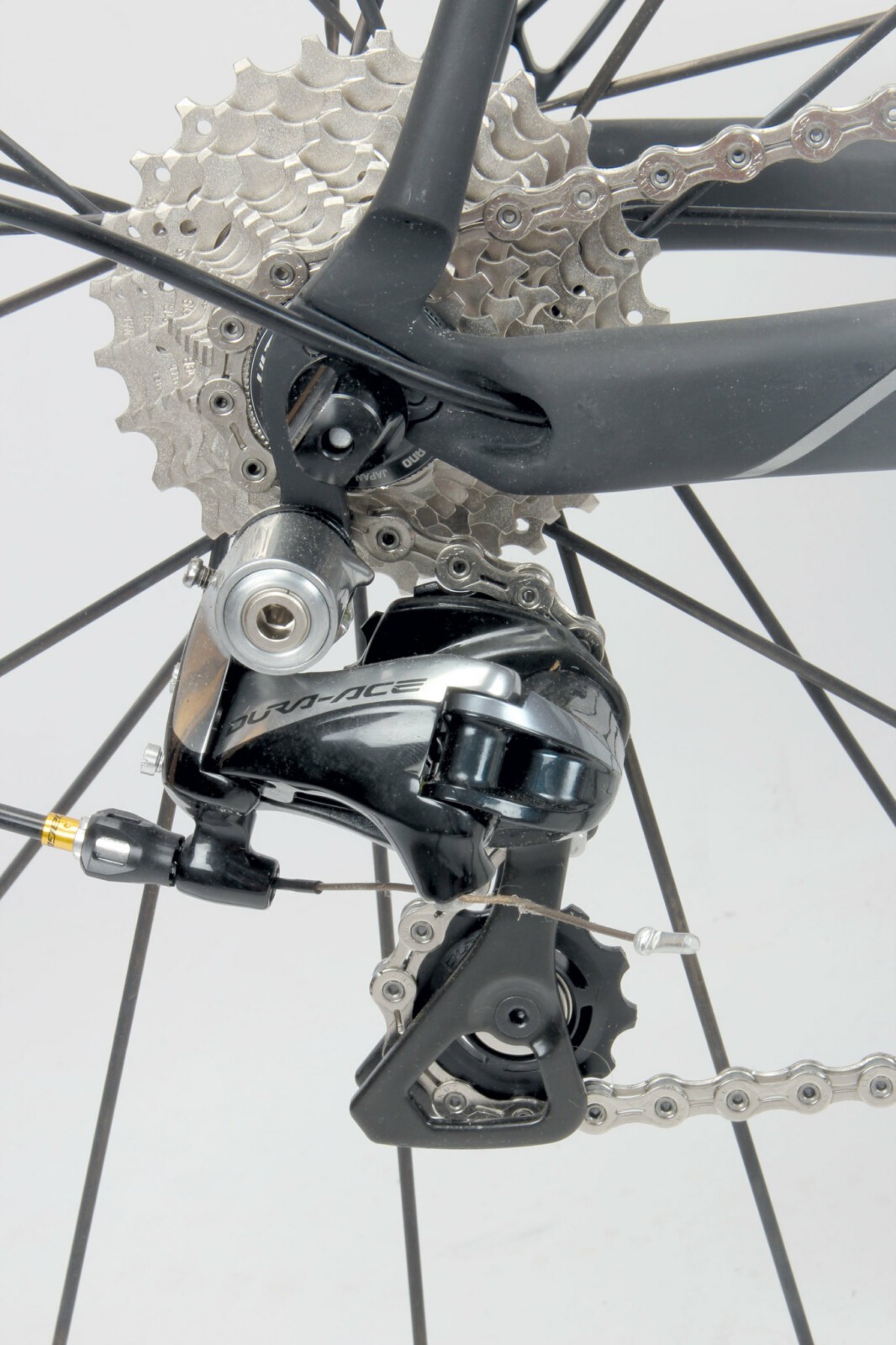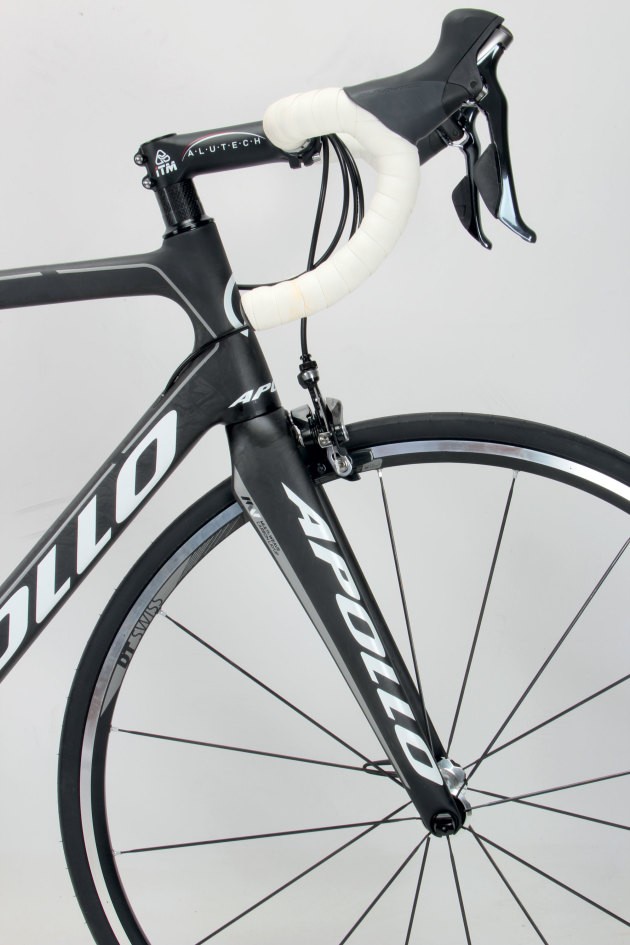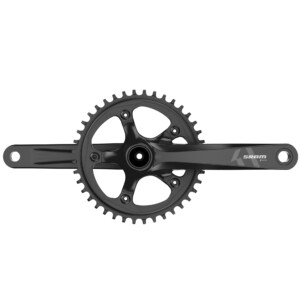When testing a racing bike, the ideal test is to race. That is just the treatment this Apollo Elite got during the 2015 Tour of Bright in the Victorian Alps. I received the Apollo about three days prior to when I was due to depart on the drive down to Bright. Usually test bikes take a few rides to bed them in and adjust bits and pieces, get the fit just right. On the Elite, however, I felt at home immediately and decided to do what is generally recommended against: ride a new, untested bike during a race. An ideal test ground for the Apollo to prove its worth.
First impressions often go a long way to determining one’s thoughts about a test bike. Visually and on the road, the first ride provides the most ideas, sensations and observations about how a bike differs from others and what type of ride it delivers. The Apollo impressed immediately, the very generously proportioned downtube draws the attention, down towards the BB86 pressfit bottom bracket, surrounded by a mass of carbon. The tube profiles are overly square in shape. This is in contrast to many of the aerodynamically focussed designs currently on the market and highlights the fact Apollo have focussed on stiffness and dynamics above creating a slippery frame. The oversized downtube and bottom bracket area contrast the spidery thin seat stays. A raw carbon finish and minimalist decals provide a reasonably stealthy appearance. Whether it was these positive initial visual impressions that made the first ride feel good or the ride itself, I’ll never know. Either way, after the first short ride of 15km or so, the Elite gave me the confidence that it was a bike built to be raced.

A couple of days later it was packed up and heading down to Bright for three days of tough racing. The Tour of Bright saw the bike perform three quite different stages. In the first stage the road bike did its best impression of a time trial machine. The handlebars were dumped and some aero bars attached, deep dish Zipp wheels fitted and bottle cages removed. Admittedly, the geometry of the Elite is not well suited to time trial adaptation. The headtube is relatively tall (160mm in the medium size).
As such, the time trial position was a little higher than ideal. The square and wide down tube cannot be highly aerodynamic either. Regardless, the handling was predictable, even when down in the aero tuck.
Day two presented a mixed 90km road stage, requiring plenty of navigating within a peloton of 100 riders and finishing up with a 6km climb up Tawonga gap. The handling was predictable within tight bunch riding situations and the fairly standard tube angles and wheelbase provided a confident ride whilst descending. Additionally, much praise needs to be given to the Dura Ace brakes. The latest offering from Shimano are certainly their best yet, with ample power and the right level of mechanical advantage to provide meaningful control.
The final, brutal stage, just 60 km, but the last 30 of which are ascending Mt Hotham; a climb taking the best part of 90 minutes. This undulating ascent is a genuine test of the climbing prowess of a bike. Whilst this rider’s legs weren’t quite at the level required to hang with the best on the climb, the Apollo Elite certainly did its part. The frame feels very light and lively. A flick of the finger on any of the main tubes of the bike delivers a noise identifying very thin wall sections. Apollo use polyurethane inserts during manufacture of the frame to control the internal surface. Achieving consistent wall thickness gives greater confidence of the frame strength allowing the manufacturer to push the boundaries and reduce weight. Despite the wafer thin tubes, the Elite is superbly stiff out of the saddle, the generous dimensions around the bottom bracket providing the rigid base through which any power delivered by my legs was more than adequately transferred. Most of the Hotham climb was spent in the small Dura Ace chainring and either the 25 or 28 tooth cogs on the rear cassette. I had cited the tall head tube earlier. For the majority of riding, the 160mm length borders on too tall, but during the long Hotham ascent, the bit of extra stack was appreciated.

During all three stages the shifting of the Dura Ace gears was flawless as you would hope for in the top offering from any manufacturer. The level of crisp and clear mechanical shifting achieved by Shimano in the 11 speed range provides a legitimate alternative to the more expensive electronic option. Apart from the need to replace cables once or twice a year, the mechanical Dura Ace would not leave you wishing for Di2.
At this stage of a review, I usually have some form of criticism to make. Usually a poor wheel choice or badly specified componentry. However, I could find little on the Elite which was not done well. The quality frame was well adorned in Dura Ace gear set, ITM stem and bars, Prologo Zero 2 saddle and Factor carbon seat mast. The DT Swiss R20 Dicut clincher wheelset was also a good match. Perhaps it could be argued that for a bike as well specified as this one, a carbon wheel set would be appropriate. The DT Swiss wheels, however, performed solidly, feeling stiff and fast. The all round performance and training suitability of a good set of alloy clinchers is hard to argue against. At 1550g for the set, the weight of the R20s is respectable too.

The Apollo Elite first impressions were good. Good enough to give the confidence to race on this bike immediately. During racing it then delivered convincingly on what was first promised. Leaving no doubt that any lack of results was due to the form of the rider, not the function of the bike. It is a good all round race machine, stiff, fast and lively. Spindly seat stays give enough compliance to keep you comfortable over longer or rougher terrain. The oversized and somewhat boxy tube design is admittedly not to everyone’s taste, but it appealed to me. The Elite perhaps does not offer the “wow factor” or any attention grabbing design features that often adorn new bikes these days, but I appreciated the Aussie-style understated nature of the bike. This is a quality build, well spec’d, from groupset to wheels and at a retail of around $5,500, it provides good value for money. Especially for those wanting to support an Australian company. It is a sad thing writing this review, because it means I now have to give the bike back.
Summing Up
Quality: the quality carbon frame is finished nicely. With a good set of components throughout.
Performance: This is a bike built to race, the frame is light and lively. The BB area is bulky and very stiff. All parts of the machine gel together well and perform as a seamless unit.
Value: $5.5k for a quality frame, Full Dura Ace, DT Swiss R20 wheels and carbon components. The Elite offers good value for money.
Overall: There was very little to fault with this bike. A great frame, and Shimano’s trusty Dura Ace combine to create a bike which raced well on the flats, was a lively climber and confidence inspiring on the descents. Apollo have created a very good all round race machine.

Specifications
Frame: Modular monocoque carbon frame. Internal cable
Fork: Full monocoque carbon fork with carbon steerer, crown and dropouts. Tapered 1-1/4 to 1-1/8 steerer.
Shifters: Shimano Dura Ace 9000 STI shifters
Front Derailleur: Shimano Dura Ace mechanical braze on
Rear Derailleur: Shimano Dura Ace mechanical
Crank: Shimano Dura Ace, 53 x 39T
Cassette: Shimano 6800 11 speed 11-25T
Bottom Bracket: Press fit BB86
Wheels: DT Swiss R20 Dicut clincher wheelset. RWS Skewers
Tyres: Hutchinson Fusion 3 700 x 25
Brakes: Shimano BR-9000 Dura Ace
Handlebar: ITM Triango 31. 8mm carbon wrapped bar
Stem: ITM Alutech 7075 3D forged 31.8mm alloy
Chain: KMC X11-L 11 speed
Saddle: Prologo Zero 2 custom
Seatpost: Factor Carbon 27.2mm
Weight: 7.16kg
Price: $5,499
Distributor: Apollo Bikes www.apollobikes.com



